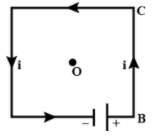
Following is a square loop, whose one arm BC produces magnetic field B at the center of the coil. The resultant magnetic field due to all the arms will be:
A.4B
B.${ B }/{ 2 }$
C.B
D.2B


Answer
571.5k+ views
Hint: The flow of current in the given square loop is in an anti-clockwise direction. Thus, the magnetic field due to any of the arms will be in the direction outside the plane of paper. So, the total magnetic field will be an addition of magnetic fields of all arms. The magnetic field of one arm is given. It's a square loop so all the arms will have the same magnetic field. Add all the magnetic fields and you will get the resultant magnetic field due to all the form arms.
Complete answer:
According to the right thumb rule, if we point the thumb of our right hand in the direction of current through the wire then the fingers will curl up in the direction of the magnetic field. Hence, the resultant magnetic field due to all the arms will be obtained by adding up their magnetic fields.
Given: The magnetic field at the center due to arm BC is B.
Therefore, magnetic field due to all the four arms at the center will be,
Total magnetic field= magnetic field due to CD + magnetic field due to DA + magnetic field due to AB +magnetic field due to BC
$\Rightarrow$ Total magnetic field= B + B + B+ B
$\Rightarrow$ Total magnetic field= 4B
Thus, the resultant magnetic field due to all the arms is 4B.
Hence, the correct answer is option A i.e. 4B.
Note:
If the flow of current was clockwise, then the direction of magnetic field will be inwards i.e. in the direction inside the plane of paper. Thus, the resultant magnetic field will be 4B. So we can say, with change in current only direction of magnetic field changes but magnitude remains the same.
Complete answer:
According to the right thumb rule, if we point the thumb of our right hand in the direction of current through the wire then the fingers will curl up in the direction of the magnetic field. Hence, the resultant magnetic field due to all the arms will be obtained by adding up their magnetic fields.
Given: The magnetic field at the center due to arm BC is B.
Therefore, magnetic field due to all the four arms at the center will be,
Total magnetic field= magnetic field due to CD + magnetic field due to DA + magnetic field due to AB +magnetic field due to BC
$\Rightarrow$ Total magnetic field= B + B + B+ B
$\Rightarrow$ Total magnetic field= 4B
Thus, the resultant magnetic field due to all the arms is 4B.
Hence, the correct answer is option A i.e. 4B.
Note:
If the flow of current was clockwise, then the direction of magnetic field will be inwards i.e. in the direction inside the plane of paper. Thus, the resultant magnetic field will be 4B. So we can say, with change in current only direction of magnetic field changes but magnitude remains the same.
Recently Updated Pages
Master Class 11 Economics: Engaging Questions & Answers for Success

Master Class 11 English: Engaging Questions & Answers for Success

Master Class 11 Social Science: Engaging Questions & Answers for Success

Master Class 11 Biology: Engaging Questions & Answers for Success

Class 11 Question and Answer - Your Ultimate Solutions Guide

Master Class 11 Business Studies: Engaging Questions & Answers for Success

Trending doubts
10 examples of friction in our daily life

One Metric ton is equal to kg A 10000 B 1000 C 100 class 11 physics CBSE

Difference Between Prokaryotic Cells and Eukaryotic Cells

1 Quintal is equal to a 110 kg b 10 kg c 100kg d 1000 class 11 physics CBSE

Explain zero factorial class 11 maths CBSE

What is a periderm How does periderm formation take class 11 biology CBSE




